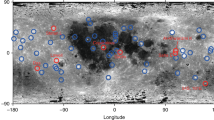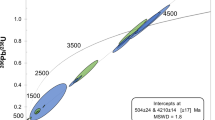Abstract
Numerous new finds of lunar meteorites in Oman allow detailed constraints to be obtained on the intensity of the transfer of lunar matter to the Earth. Our estimates show that the annual flux of lunar meteorites in the mass interval from 10 to 1000 g to the entire Earth's surface should not be less than several tenths of a kilogram and is more likely equal to tens or even a few hundred kilograms, i.e., a few percent of the total meteorite flux. This corresponds to several hundred or few thousand falls of lunar meteorites on all of Earth per year. Even small impact events, which produce smaller than craters on the Moon smaller than 10 km in diameter, are capable of transferring lunar matter to the Earth. In this case, the Earth may capture between 10 to 100% of the mass of high-velocity crater ejecta leaving the Moon. Our estimates for the lunar flux imply rather optimistic prospects for the discovery of new lunar meteorites and, consequently, for the analyses of the lunar crust composition. However, the meteorite-driven flux of lunar matter did not play any significant role in the formation of the material composition of the Earth's crust, even during the stage of intense meteorite bombardment.
Similar content being viewed by others
REFERENCES
Arnold, J.R., The Origin of Meteorites as Small Bodies. II. The Model,Astrophys. J., 1965, vol. 141, pp. 1536-1547.
Demidova, S.I., Nazarov, M.A., Anand, M.,et al., Clast Population of Lunar Regolith Breccia Dhofar 287B,Lunar Planet. Sci. Conf. XXXIII, 2002, Abstract #1290.
Demidova, S.I., Nazarov, M.A., and Taylor, L.A., Dhofar 304, 305, 306, and 307: New Lunar Highland Meteorites,Lunar Planet. Sci. Conf. XXXIV, 2003, Abstract #1285.
Eremeeva, A.I.,Rozhdenie nauchnoi meteoritiki(Origin of Scientific Meteoritics), Moscow: Nauka, 1982.
Gault, D.E., The Terrestrial Accretion of Lunar Material,Proc. Lunar Planet. Sci. Conf. XIV, 1983, pp. 243-244.
Grossman, J.N., The Meteoritical Bulletin no. 84,Meteorit. Planet. Sci., 2000, vol. 35, pp. A199-A225.
Grossman, J.N. and Zipfel, J., The Meteoritical Bulletin no. 85,Meteorit. Planet. Sci., 2001, vol. 36, pp. A293-A322.
Halliday, I., Blackwell, A.T., and Griffin, A.A., The Flux of Meteorites on the Earth's Surface,Meteoritics,1989, vol. 24, pp. 173-178.
Harvey, R.P. and Cassidy, W.A., A Statistical Comparison of Antarctic Finds and Modern Falls: Mass Frequency Distributions and Relative Abundance by Type,Meteoritics, 1989, vol. 24, pp. 9-14.
Hughes, D.W., Earth's Cratering Rate,Nature, 1979, vol. 281,no. 5726, p. 11.
Kyte, F.T. and Wasson, J.T., Accretion Rate of Extraterrestrial Matter: Iridium Deposited 33 to 67 Million Years Ago,Science, 1986, vol. 232, pp. 1225-1229.
Lindstrom, M.M., Schwarz, C., Score, R.,et al., MacAlpine Hills 88104 and 88105 Lunar Highland Meteorites: General Description and Concortium Overview,Geochim. Cosmochim. Acta, 1991, vol. 55, pp. 2999-3008.
Melosh, H.J., Impact Cratering: a Geologic Process,Oxford Monographs on Geology and Geophysics, No. 11, New York: Clarendon, 1989.
Nazarov, M.A., Demidova, S.I., Patchen, A.,et al., Dhofar 301, 302 and 303: Three New Lunar Highland Meteorites from Oman,Lunar Planet. Sci. Conf. XXXIII, 2002, Abstract #1293.
Nazarov, M.A., Demidova, S.I., and Taylor, L.A., Trace Element Chemistry of Lunar Highland Meteorites from Oman,Lunar Planet. Sci. Conf. XXXIV, 2003, Abstract #1636.
Nishiizumi, K., Caffee, M.W., Jull, A.J.T.,et al., Exposure History of Lunar Meteorites Queen Alexandra Range 93069 and 94269,Meteorit. Planet. Sci., 1996, vol. 31, pp. 893-896.
Nishiizumi, K. and Caffee, M.W., Exposure histories of lunar meteorites Dhofar 025, 026, and Northwest Africa 482,Meteorit. and Planet. Sci., 2001, vol. 36, p. A148.
Nishiizumi, K., Okazaki, R., Park, J.,et al., Exposure and Terrestrial Histories of Dhofar 019 Martian Meteorite,Lunar Planet. Sci. Conf. XXXIII, 2002, Abstract #1366.
O'Keefe, J.D. and Ahrens, T.J., Meteorite Impact Ejecta: Dependence of Mass and Energy Lost on Planetary Escape Velocity,Science, 1977, vol. 198, pp. 1249-1251.
Ronov, A.B.,Osadochnaya obolochka Zemli (kolichestvennye zakonomernosti stroeniya, sostava i evolyutsii)(The Earth's Sedimentary Layer: Quantitative Regularities of Structure, Composition, and Evolution), Moscow: Nauka, 1980.
Russel, S.S., Zipfel, J., Grossman, J.N.,et al., The Meteoritical Bulletin, no. 86,Meteorit. Planet. Sci., 2002, vol. 37, pp. 157-184.
Russel, S.S., Zipfel, J., Folco, L.,et al., The Meteoritical Bulletin, no. 87,Meteorit. Planet. Sci., 2003, vol. 38 (in press).
Score, R. and Lindstrom, M.M., Guide to the U.S. Collection of Antarctic Meteorites 1976–1988,Antarctic Meteorite Newsletter, 1990, vol. 13.
Semenova, A.S., Nazarov, M.A., and Guseva, E.V., Lunar Meteorite MAC 88105: Petrology of Igneous Rock Clasts,Lunar Planet. Sci. Conf. XXIII, 1992, pp. 1265-1266.
Semenova A.S., Nazarov M.A., and Kononkova N.N., Petrology of lunar meteorites MAC 88105 and EET 87521,Petrologiya, 1993, vol. 1,no. 6, pp. 624-633.
Shukolyukov, Yu.A., Nazarov, M.A., Pätsch, M.,et al., Noble Gases in Three Meteorites from Oman,Lunar and Planetary Sci. Conf. XXXII, 2001, Abstract #1502.
Taylor, L.A., Nazarov, M.A., Cohen, B.A.,et al., Bulk Chemistry and Oxygen Isotopic Composition of Lunar Meteorites Dhofar 025 and Dhofar 026,Lunar Planet. Sci. Conf. XXXII, 2001, Abstract #1985.
Taylor, L.A., Nazarov, M.A., Demidova, S.I.,et al., Dhofar 287: A new mare lunar basalt from Oman,Meteorit. Planet. Sci., 2001, vol. 36, p. A204.
Thalmann, Ch., Eugster, O., Herzog, G.F.,et al., History of Lunar Meteorites Queen Alexandra Range 93069, Asuka 881757, and Yamato 793169 Based on Noble Gas Isotopic Abundances, Radionuclide Concentrations, and Chemical Composition,Meteorit. Planet. Sci.,1996, vol. 31, pp. 857-868.
Tsvetkov, V.I. and Goritskii, Yu.A., Probabilistic Estimation of Dispersion Assymetry for Meteorite Showers,Astron. Vestn., 1973, vol. 7,no. 3, pp. 160-166.
Vogt, S., Fink, D., Klein, J.,et al., Exposure Histories of the Lunar Meteorites: MAC 88104, MAC 88105, Y 791197, and Y 86032,Geochim. Cosmochim. Acta, 1991, vol. 55, pp. 3157-3165.
Warren, P.H., Lunar and Martian Meteorite Delivery Services,Icarus, 1994, vol. 111, pp. 338-363.
Author information
Authors and Affiliations
Rights and permissions
About this article
Cite this article
Nazarov, M.A., Badyukov, D.D., Lorents, K.A. et al. The Flux of Lunar Meteorites onto the Earth. Solar System Research 38, 49–58 (2004). https://doi.org/10.1023/B:SOLS.0000015155.90844.ae
Issue Date:
DOI: https://doi.org/10.1023/B:SOLS.0000015155.90844.ae




